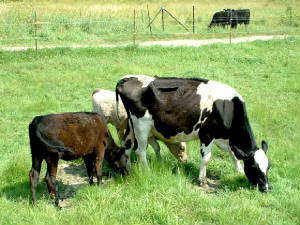|
| ELMARTIN FARM CATTLE |

|
| Holstein - Black Angus - Charolait - Cross-breeds |
Breeds for Reasons
As with other animals
which are bred for purposes, there are numerous breeds of cattle which have been genetical "perfected" for a purpose.
While all breeds have
cows and bulls, most breeds are known for being best as "milkers" or "beef." Of course, most all cows produce enough
milk to feed their young; however, some breeds produce even more milk, and / or a specialized form of milk. The same
holds true for bulls and steers; they all produce beef, however some more so... or at a more economical feed-to-beef rate,
or for a meat characteristic.
Over the years, at Elmartin, many of the popular breeds have been bred, raised,
and milked or slaughtered for beef. Links on this page lead to more information regarding each breed which has
been housed at the farm.
We hope that you enjoy the reading. For people desiring to "get into
the beef business" with Elmartin Farm, we recommend that you pay particular attention to the beef breeds.
While "Black Angus Beef" is currently popular and taste-wise deservedly so, it is not the only "tasty, juicy, and delicious"
piece of meat on the table.
THE BELOW LINKS REFERENCE CATTLE
BREEDS
AT ELMARTIN FARM OVER THE YEARS


 |
 |
What Is A Breed?
The classic definition of a "breed" is usually
stated as a variation of this statement. "Animals that, through selection and breeding, have come to resemble
one another and pass those traits uniformly to their offspring."
Unfortunately this definition leaves some unanswered
questions. For example, when is a crossbred animal considered a composite breed and when do we stop thinking about them as
composites? Perhaps this definition from The Genetics of Populations by Jay L. Lush helps explain
why a good definition of "breed" is elusive: "A breed is a group of domestic animals, termed such by common consent of the breeders, ... a term which
arose among breeders of livestock, created one might say, for their own use, and no one is warranted in assigning to this
word a scientific definition and in calling the breeders wrong when they deviate from the formulated definition. It is their
word and the breeders common usage is what we must accept as the correct definition."
As you can see from Dr. Lushes definition it is at
least in part the perception of the breeders and the livestock industry which decides when a group of individuals constitutes
a "breed".
The development of the breeds takes different routes
also. In some breeds you can see the amount of change that can occur as the result of selection for a small number of traits.
As an example, Holstein cattle have been selected primarily for milk production
and are the highest milk producing cattle in the world. Other breeds have traits that result from natural selection pressure
based upon the environment in which they were developed. An example of this might be the N'dama cattle from West Africa. These animals have, through
the centuries, developed a resistance to trypanosomiasis or sleeping sickness spread by the tse-tse fly, which is fatal to
most other breeds of cattle.
Why are we concerned about preserving information
about minor, or relatively unknown, breeds of livestock? Is there a reason for the preservation of minor breeds of livestock?
Couldn't more improvement be made if there were fewer breeds?
Well, lets go back to our Holstein example again for a moment. While the Holstein
clearly has an advantage over other breeds in the production of whole milk, this advantage is based on feeding high levels
of cereal grains and pricing that favors low milk-solids content. A drastic change in either of these factors could result
in a decrease in the advantage of the Holstein. Given these conditions perhaps a breed that is currently rare or endangered,
such as the Dutch Belted, which displayed excellent milking ability in a grass-based dairy situation in trials in the early 1900's, would find
itself on the forefront. In Australia, composite breeds, such as the Australian Friesian Sahiwal, have been developed which
have higher milk production levels than Holsteins in the tropical regions of that country.
Therefore, if for no reason other than maintaining
a genetic pool which someday may be needed 1) to offset a naturally occurring inheritable weaknesses, and 2)
to meet the potential challenges resulting from changes in production resources and market requirements, it makes medical
and economic sense to maintain "exotic" breeds for their genetic diversity and their potential contribution to cross-breeding
out weaknesses and disadvantages.
The above is adapted from
"Breeds of Livestock "
Department of Animal Science at Oklahoma State University
|
|
 |
 |
|

